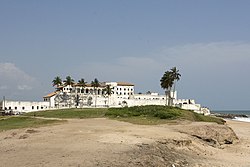Museums in Ghana are administered by the Ghana Museums and Monuments Board (GMMB). The agency's history starts with the establishment of an Ethnographic Museum at Achimota College in 1929. The museum was transferred to the Department of Archaeology at the University of the Gold Coast, when the establishment was opened in 1948. [1]
Contents
In order to preserve the country's past, the British set up an "Interim Council of the National Museum of the Gold Coast", focus on the creation of a national museum. [2] Both the "Interim Council of the National Museum of the Gold Coast" and the Monuments and Relics Commission merged, leading to the passing of the Museum and Monuments Board Ordinance (GOLD COAST No. 20 of 1957), resulting in the establishment of the GMMB. [1] [3]
There are approximately 28 museums located in the country. [4] The following is a list of museums, including botanical collections and gardens, in Ghana.













